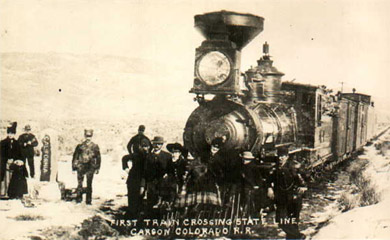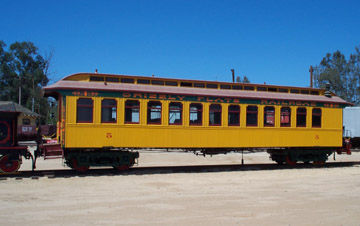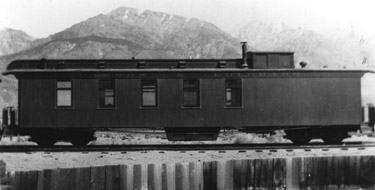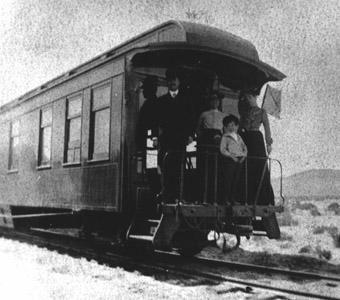Carson & Colorado Railway
 The Carson & Colorado was incorporated on May 10, 1880. The 293 mile long narrow gauge short line railroad connected the Virginia & Truckee Railway at Mound House with the mining towns south of the Carson Valley.
The Carson & Colorado was incorporated on May 10, 1880. The 293 mile long narrow gauge short line railroad connected the Virginia & Truckee Railway at Mound House with the mining towns south of the Carson Valley.
Service to Hawthorne began in April 1881, and Benton, California in January 1883.Unfortunately the Bodie boom was over and mining started a steady decline. The line continued down the Owens Valley to a terminus at Hawley, later renamed Keeler, east of Owens Lake. The route reached an altitude of 7100 feet in Montgomery Pass. Stations included Dayton, Hawthorne and Candelaria in Nevada, Benton Station, Laws, Kearsarge, Owenyo and Hawley (later Keeler) in California.
After several years of declining revenue, the C&C was sold to the Southern Pacific in March 1900 for a reported $2,750,000. In May the same year, however, Jim Butler and his wandering mule discovered silver at Tonopah. The resulting boom, along with the boom following the discovery of gold at Goldfield two years later, increased revenues of both railroads for the next decade.
In 1905 the northern portion of the line, from Mound House to Tonopah Junction, was converted to standard gauge track. A direct connection from Churchill, Nevada with the Southern Pacific main line at Hazen, Nevada was constructed to overcome freight tie-up problems at Mound House and bypass the Virginia & Truckee Railroad.
From 1900 through 1905 the Carson & Colorado Railway was operated as a wholly-owned subsidiary of the Southern Pacific. In 1905 the railway was incorporated as the Nevada & California Railway Company also a wholly-owned subsidiary of the Southern Pacific.
In 1912 the N & C Railway was transferred to the Central Pacific subsidiary of the Southern Pacific. Portions of the line were abandoned in the 1930's and the 1940's, and operations ceased entirely by 1960.
 Coach No. 5 exhibited at Orange Empire Railway Museum
Coach No. 5 exhibited at Orange Empire Railway Museum
Carson & Colorado Coach No. 5 was built in 1881 as a First Class Coach by the Barney & Smith Manufacturing Company, Dayton, Ohio.
The wooden coach was a part of a seven car order made for the Carson & Colorado by Henry Yerington. The order called for the cars to be finished in "cherry red" paint with gold lettering. Car Nos. 1, 2, 5 and 7 were coaches, with car nos. 1 and 5 designated as smokers. The bagage-mail-express cars were Nos. 3, 4, and 6.
Coach No. 5 was rebuilt in 1900, following the acquisition of the Carson & Colorado by the Southern Pacific. An interior partition was added to provide a smoking section, which would allow the railroad to use a single passenger coach on a train. The passenger cars were painted "SP coach green" and lettered Southern Pacific at this time.
Coach No. 5 was retired by the railroad in 1938. It was acquired by Ward Kimball for the Grizzly Flats Railroad. Ward Kimball repainted the exterior of the car for the Grizzly Flats Railroad, but preserved the interior in its as-received condition.
Business Car No. 10, Esmeralda, exhibited at Orange Empire Railway Museum
 The Esmeralda was built by the Virginia & Truckee Railroad shops at Carson City, Nevada. According to Stephen Drew, Curator, California State Railroad Museum, V & T Shop records indicate that the car was built as the second Carson & Colorado superintendent's car, number 10, during the winter of 1895-1896. The car was placed in service May 12, 1896.
The Esmeralda was built by the Virginia & Truckee Railroad shops at Carson City, Nevada. According to Stephen Drew, Curator, California State Railroad Museum, V & T Shop records indicate that the car was built as the second Carson & Colorado superintendent's car, number 10, during the winter of 1895-1896. The car was placed in service May 12, 1896.
The car was built at the direction of Carson & Colorado President and General Superintendent Henry M. Yerington.
Narrow gauge business car number 10 was patterned after the shorter caboose combines 1 and 2. Yerington had previously used caboose combine number 2 as a business car but desired a larger car. Number 10 was built 50' 3" long by 8' 2" wide, 9' longer than caboose combine number 2. It was built with a clerestory roof covering 2/3 of the length of the car, a cupola, and a standard roof covering the remainder of the car.
Occasionally the narrow gauge trucks were switched for standard gauge trucks at Mound House, Nevada, northern terminus of the C & C, for movement of the car over the Virginia & Truckee Railroad. Yerington and the other officials of the C & C were also officials of the V & T, general offices for both railroads were located in the V & T Railroad Depot in Carson City, Nevada.
 The sale in 1900 included business car number 10 along with the railway's
other equipment. C & C Assistant General Superintendent Robert J. Laws was retained by the Southern Pacific. Laws took over use of the car.
The sale in 1900 included business car number 10 along with the railway's
other equipment. C & C Assistant General Superintendent Robert J. Laws was retained by the Southern Pacific. Laws took over use of the car.
In May 1903 the car was rebuilt by the Southern Pacific shops in Sacramento, California. The cupola was removed and clerestory roof was extended to the full length of the car. Windows were relocated and additional windows added. As outshopped the interior included a parlor, dining room, bedroom, bathroom and kitchen. A Baker heater was also added.
According to Richard Datin, Reno, Nevada, business car number 10 was also named in 1903. P. J. Mc Grath, of the C & C wrote to Yerington asking his opinion on naming the car the Esmeralda. Yerington was reportedly delighted with the name. Spanish for emerald, the name Esmeralda is believed to have come from the Esmeralda Mining District which provided the greatest amount of business to the railroad. Esmeralda County was also named after the mining district.
Little information is recorded about the car after 1912. In 1928 the Esmeralda was detrucked for use at Keeler as a train crew sleeping quarters and later as a section gang dwelling. The car body was acquired by Mr. & Mrs. Charles Brown who moved it to their property for use as a guest house. It was donated to Orange Empire Railway Museum by Mrs. Charles Brown.
For additional reading:
- Beebe, Lucius and Charles Clegg. Steamcars to the Comstock. Berkeley, California: Howell-North Books, 1957.
- Ferrell, Mallory Hope. Southern Pacific Narrow Gauge. Edmonds, Washington: Pacific Fast Mail, 1982.
- Turner, George. Slim Rails Through the Sand. Los Angeles, California: Trans-Anglo Books, 1964.
Sharing A Heritage Railroad History Train Technology Railroad Operation Railroad Time Museums & Heritage Railroads Railroads Today
